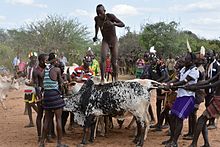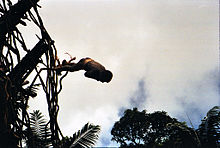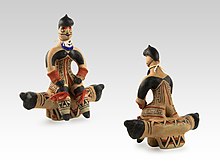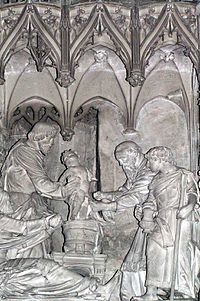Rite of passage
| Part of a series on |
| Anthropology of religion |
|---|
 |
| Social and cultural anthropology |
A rite of passage is a ceremony or ritual of the passage which occurs when an individual leaves one group to enter another. It involves a significant change of status in society. In cultural anthropology the term is the Anglicisation of rite de passage, a French term innovated by the ethnographer Arnold van Gennep in his work Les rites de passage, "The Rites of Passage".[1] The term is now fully adopted into anthropology as well as into the literature and popular cultures of many modern languages.
Original conception[]
In English, Van Gennep's first sentence of his first chapter begins:[2]
"Each larger society contains within it several distinctly separate groupings. ... In addition, all these groups break down into still smaller societies in subgroups."
The population of a society belongs to multiple groups, some more important to the individual than others. Van Gennep uses the metaphor, "as a kind of house divided into rooms and corridors."[3] A passage occurs when an individual leaves one group to enter another; in the metaphor, he changes rooms.
Van Gennep further distinguishes between "the secular" and "the sacred sphere." Theorizing that civilizations are arranged on a scale, implying that the lower levels represent "the simplest level of development," he hypothesizes that "social groups in such a society likewise have magico-religious foundations." Many groups in modern industrial society practice customs that can be traced to an earlier sacred phase. Passage between these groups requires a ceremony, or ritual hence rite of passage.
The rest of Van Gennep's book presents a description of rites of passage and an organization into types, although in the end he despairs of ever capturing them all:[4] "It is but a rough sketch of an immense picture ...." He is able to find some universals, mainly two: "the sexual separation between men and women, and the magico-religious separation between the profane and the sacred." (Earlier the translators used secular for profane.) He refuses credit for being the first to recognize type of rites. In the work he concentrates on groups and rites individuals might normally encounter progressively: pregnancy, childbirth, initiation, betrothal, marriage, funerals and the like. He mentions some others, such as the territorial passage, a crossing of borders into a culturally different region, such as one where a different religion prevails.
Stages[]
Rites of passage have three phases: separation, liminality, and incorporation, as van Gennep described. "I propose to call the rites of separation from a previous world, preliminal rites, those executed during the transitional stage liminal (or threshold) rites, and the ceremonies of incorporation into the new world postliminal rites."[5]
In the first phase, people withdraw from their current status and prepare to move from one place or status to another. "The first phase (of separation) comprises symbolic behavior signifying the detachment of the individual or group ... from an earlier fixed point in the social structure."[6] There is often a detachment or "cutting away" from the former self in this phase, which is signified in symbolic actions and rituals. For example, the cutting of the hair for a person who has just joined the army. He or she is "cutting away" the former self: the civilian.
The transition (liminal) phase is the period between stages, during which one has left one place or state but has not yet entered or joined the next. "The attributes of liminality or of liminal personae ("threshold people") are necessarily ambiguous."[7]
In the third phase (reaggregation or incorporation) the passage is consummated [by] the ritual subject."[8] Having completed the rite and assumed their "new" identity, one re-enters society with one's new status. Re-incorporation is characterized by elaborate rituals and ceremonies, like debutant balls and college graduation, and by outward symbols of new ties: thus "in rites of incorporation there is widespread use of the 'sacred bond', the 'sacred cord', the knot, and of analogous forms such as the belt, the ring, the bracelet and the crown."[9]
Psychological effects[]
Laboratory experiments have shown that severe initiations produce cognitive dissonance.[10] It is theorized that such dissonance heightens group attraction among initiates after the experience, arising from internal justification of the effort used.[11] Rewards during initiations have important consequences in that initiates who feel more rewarded express stronger group identity.[12] As well as group attraction, initiations can also produce conformity among new members.[13] Psychology experiments have also shown that initiations increase feelings of affiliation.[14]
Cultural[]

Initiation rites are seen as fundamental to human growth and development as well as socialization in many African communities. These rites function by ritually marking the transition of someone to full group membership.[15] It also links individuals to the community and the community to the broader and more potent spiritual world. Initiation rites are "a natural and necessary part of a community, just as arms and legs are natural and necessary extension of the human body". These rites are linked to individual and community development. Dr. Manu Ampim identifies five stages; rite to birth, rite to adulthood, rite to marriage, rite to eldership and rite to ancestorship.[16] In Zulu culture entering womanhood is celebrated by the Umhlanga.
Types and examples[]
Rites of passage are diverse, and are found throughout many cultures around the world. Many western societal rituals may look like rites of passage but miss some of the important structural and functional components. However, in many Native and African-American communities, traditional rites of passage programs are conducted by community-based organizations such as Man Up Global. Typically the missing piece is the societal recognition and reincorporation phase. Adventure education programs, such as Outward Bound, have often been described as potential rites of passage. Pamela Cushing researched the rites of passage impact upon adolescent youth at the Canadian Outward Bound School and found the rite of passage impact was lessened by the missing reincorporation phase.[17] Bell (2003) presented more evidence of this lacking third stage and described the "Contemporary Adventure Model of a Rites of Passage" as a modern and weaker version of the rites of passage typically used by outdoor adventure programs.
Coming of age[]


This section does not cite any sources. (June 2018) |
In various tribal and developed societies, entry into an age grade—generally gender-separated—(unlike an age set) is marked by an initiation rite, which may be the crowning of a long and complex preparation, sometimes in retreat.
- Bar and Bat Mitzvah
- Breeching, when an infant is put into boy's clothing
- Coming of Age in Unitarian Universalism
- Completion of toilet training
- Débutante ball
- Dokimasia
- First menstruation, i.e. menarche
- Seclusion of girls at puberty
- Sevapuneru or Turmeric ceremony
- Graduation
- Okuyi in several West African nations
- Quinceañera
- Retirement
- Russefeiring in Norway
- Scarification and various other physical endurances
- Secular coming of age ceremonies for non-religious youngsters who want a rite of passage comparable to the religious rituals like confirmation
- Shinbyu
- Sweet Sixteen
- Wedding
- Walkabout
Religious[]

- Amrit Sanchar in Sikhism
- Annaprashana
- Baptism (Christening)
- Bar and Bat Mitzvah in Judaism
- Circumcision
- Bris in Judaism
- Khitan in Islam[18][19][20][21]
- In Coptic Christianity and the Ethiopian Orthodox Church[22][23]
- Consecration in Reform Judaism
- Confirmation in Western Christianity
- Diving for the Cross, in some Orthodox Christian churches
- First Communion, First Eucharist and First Confession
- Siddur presentation ceremony in Judaism
- Bible presentation ceremony in several branches of Protestantism
- Hajj in Islam
- Chudakarana, or hair cutting in Hinduism
- Rumspringa
- Sanskara, a series of sacraments in Hinduism
- Shinbyu in Theravada Buddhism
- Vision quest in some Native American cultures
- Wiccaning in Wicca
Military[]
- Boot Camp and Officer Candidate School are rites of passage from civilian to military life. In the United States Navy's Officer Candidate School and the United States Marine Corps, Drill Instructors manufacture stress as a form of training.
- Blood wings
- Line-crossing ceremony
- Krypteia, a rite involving young Spartans, part of the agoge regime of Spartan education.
- Ephebeia, a training period for young Athenians
- Wetting-down. In the U.S. Navy and Royal Navy, is a ceremony in which a naval officer throws a party for his shipmates upon receiving a promotion.
Academic[]
- The first day of school, whether the first overall or the first in a specific phase prior to postsecondary education
- Graduation
- Matura
Some academic circles such as dorms, fraternities, teams and other clubs practice hazing, ragging and fagging. Szecskáztatás, a mild form of hazing (usually without physical and sexual abuse), is practiced in some Hungarian secondary schools. First-year junior students are publicly humiliated through embarrassing clothing and senior students branding their faces with marker pens; it is sometimes also a contest, with the winners usually earning the right to organize the next event. Fraternities and sororities, like other private societies, often have codified initiation ceremonies as ritual separating candidates from members.
Vocational/professional[]
- White coat ceremony in medicine and pharmacy.
- The Ritual of the Calling of an Engineer, also known as the Iron Ring Ceremony
- Walk on Water: Second-year students must pass the competition to continue in the school of architecture at Florida International University in the United States
- A student pilot successfully completing a First solo flight traditionally gets drenched with water and has his or her shirt tail cut off.
Sports[]
- Batizados in Capoeira
- Black belt in martial arts
- Blooding in fox hunting
- A National Hockey League player's first goal (The puck used to score said goal may be retrieved, labeled, and given to the player as a keepsake.)
Other[]
- Castration in some sects and special castes
- Dental evulsion, among various cultures of Africa, Asia and Oceania.
- Earlier seasons of the television series Survivor typically include a rite of passage prior to the final immunity challenge. Though the specifics of this rite of passage vary based on the customs and traditions of the host country, most rites of passage include a lengthy walk to the final challenge along which the remaining castaways pass the torches of every eliminated contestant from that season. There have been variations on this walk, such as seasons in which the remaining contestants paddle a boat to the final challenge and drop the torches into the ocean along the way.
See also[]
References[]
- ^ Van Gennep 1909, Lay Summary
- ^ Van Gennep, Vizedom & Caffee 2010, I. The Classification of Rites
- ^ Journet, Nicolas (1 January 2001). "Les rites de passage". Sciences Humaines (112).
chaque société générale peut être considérée comme une sorte de maison divisée en chambres et couloirs
- ^ Van Gennep, Vizedom & Caffee 2010, X. Conclusions
- ^ van Gennep 1977: 21
- ^ Turner 1969: 80.
- ^ Turner 1969: 95
- ^ Turner 1969: 80
- ^ van Gennep 1977: 166
- ^ Aronson & Mills 1959.
- ^ Festinger 1961.
- ^ Kamau 2012.
- ^ Keating et al. 2005.
- ^ Lodewijkx et al. 2005.
- ^ "African Culture Complex". Retrieved 2011-10-04.
- ^ The Five Major African Initiation Rites Prof. Manu Ampim
- ^ Cushing 1998.
- ^ Morgenstern 1966.
- ^ "Rites of Passage". Oxford Islamic Studies Online. 2013. Retrieved 27 May 2013.
- ^ "Traditional Muslim Male Circumcision: Performed by Arabs, Turkish, Malaysian and Others of this faith". CIRCLIST. 1992–2013. Retrieved 27 May 2013.
- ^ Hamid, Ismail (2005). "Islamic Rites of Passage". The Encyclopedia of Malaysia Volume 10: Religions and Beliefs. Archived from the original on 30 June 2013. Retrieved 27 May 2013.
- ^ Thomas Riggs (2006). "Christianity: Coptic Christianity". Worldmark Encyclopedia of Religious Practices: Religions and denominations. Thomson Gale. ISBN 978-0-7876-6612-5.
- ^ "Circumcision". Columbia Encyclopedia. Columbia University Press. 2011.
Bibliography[]
- Aronson, E. & Mills, J. (1959) "The effect of severity of initiation on liking for a group." Journal of Abnormal and Social Psychology', pp. 177–181.
- Bell, B.J. (2003). "The rites of passage and outdoor education: Critical concerns for effective programming". The Journal of Experiential Education. 26 (1): 41–50. doi:10.1177/105382590302600107. S2CID 143370636.
- Cushing, P.J. (1998). "Competing the cycle of transformation: Lessons from the rites of passage model". Pathways: The Ontario Journal of Experiential Education. 9 (5): 7–12.
- Festinger, L (1961). "The psychological effects of insufficient rewards". American Psychologist. 16 (1): 1–11. doi:10.1037/h0045112.
- Garces-Foley, Kathleen (2006). Death and religion in a changing world. ME Sharpe.
- Kamau, C (2012). "What does being initiated severely into a group do? The role of rewards". International Journal of Psychology. 48 (3): 399–406. doi:10.1080/00207594.2012.663957. PMID 22512542.
- Keating, C. F.; Pomerantz, J.; Pommer, S. D.; Ritt, S. J. H.; Miller, L. M.; McCormick, J. (2005). "Going to college and unpacking hazing: A functional approach to decrypting initiation practices among undergraduates". Group Dynamics: Theory, Research, and Practice. 9 (2): 104–126. CiteSeerX 10.1.1.611.2494. doi:10.1037/1089-2699.9.2.104.
- Lodewijkx, H. F. M.; van Zomeren, M.; Syroit, J. E. M. M. (2005). "The anticipation of a severe initiation: Gender differences in effects on affiliation tendency and group attraction". Small Group Research. 36 (2): 237–262. doi:10.1177/1046496404272381. S2CID 146168269.
- Morgenstern, Julian (1966). Rites of Birth, Marriage, Death, and Kindred Occasions among the Semites. Cincinnati.
- Turner, Victor (1967). "Betwixt and between: the liminal period in rites de passage". Forest of symbols: aspects of the Ndembu ritual. Ithaca: Cornell UP. pp. 23–59.
- Turner, Victor W. (1969). The Ritual Process. Penguin.
- Van Gennep, Arnold (1909). Les rites de passage (in French). Paris: Émile Nourry. Lay summary – Review by Frederick Starr, The American Journal of Sociology, V. 15, No. 5, pp 707-709 (March 1910).
- ——; Vizedom, Monika B (Translator); Caffee, Gabrielle L (Translator) (1977) [1960]. The Rites of Passage. Routledge Library Editions Anthropology and Ethnography (Paperback Reprint ed.). Hove, East Sussex, UK: Psychology Press. ISBN 978-0-7100-8744-7.
- ——; ——; —— (2010) [1960]. The Rites of Passage (Reprint ed.). Routledge. ISBN 978-0-415-61156-5.
Further reading[]
- Hatzopoulos, Miltiades B., "Macedonian Cults" (as "Cultes et rites de passage en Macédoine"), Athens & Paris, 1994
- Devine, A.M., "Review: Macedonian Cults", The Classical Review, New Series, Vol. 46, No. 2 (1996), pp. 279–281, Cambridge University Press on behalf of The Classical Association
- Padilla, Mark William (editor), "Rites of Passage in Ancient Greece: Literature, Religion, Society", Bucknell University Press, 1999. ISBN 0-8387-5418-X
External links[]
- Dictionary.com: Rites of Passage
- McCray, Kenja (2018). "'Talk Doesn't Cook the Soup': Reflections on a Collegiate Rites of Passage Program". Murmurations: Emergence, Equity and Education. 1 (1): 20–28. doi:10.31946/meee.v1i1.28.
- Ceremonies
- Rites of passage
- Anthropology of religion
